BLOG ARTICLE
How To Summarize a Podcast For Free in 2025
Last updated: 1/21/2025
Last updated: 1/21/2025
One crucial aspect when publishing your podcast episode is the summary in your show notes. This is because, after your title, the summary is what a potential listener encounters next. To engage listeners and encourage them to hit "play," having a compelling summary is key—it needs to be more than just good, it should be captivating.
So, how do you craft a compelling summary for your podcast episode? What are the key elements that elevate a podcast summary from good to great? This guide is here to help.
We'll explore effective strategies for summarizing your podcast episode, including advanced tips to make your summaries stand out.
Furthermore, with tools like Podsqueeze, summarizing your podcast can be as simple as clicking a button. Podsqueeze is an all-in-one tool that simplifies podcast content creation, offering features like show notes, transcriptions, and even short videos for your podcast..

What's a podcast summary?
A podcast summary is a brief description or overview of the content you covered in a specific episode. It is a snapshot or an interesting written highlight of what listeners can expect to learn from your content. It highlights key topics, guests, or discussions that make up your episode. The goal is to provide a quick and enticing glimpse that encourages people to listen to the full show.
Why is podcast summary important?
After your episode title, a podcast summary is the next thing that compels a listener to check your episode. In today's fast-paced world, the average adult internet user's attention span is 8.25 seconds. With more distractions than ever before, a podcast summary is a fix that brings potential listeners into the context of your episode without actually listening to it.
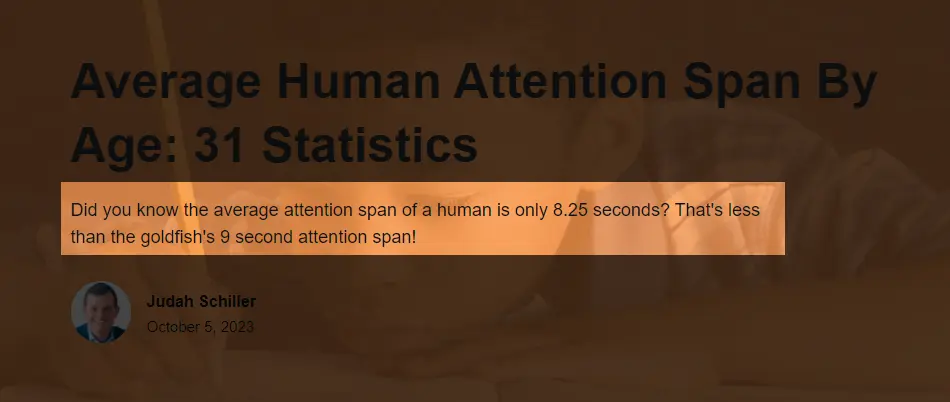
That's why you need podcast summaries.
Additionally, if you can summarize your podcast sweetly and concisely (just like you'll learn in this guide), you can increase your episodes' listenership, your show's reach, discoverability, and the overall scalability of your podcast.
How to summarize a podcast
There are 2 ways we've mentioned in this guide on how to summarize your podcast episode. It can be using AI-assisted tools and or to summarize the episode manually. Either way, we've compiled all the steps needed for both methods.
How to summarize a podcast with Podsqueeze
With Podsqueeze, you can summarize your podcast episode with human-level accuracy with one click, using AI. Also, you can generate your episode title, highlights as bullet points and complete show notes.
Here's how it works.
Step 1: Create a free Podsqueeze account
You don't need a credit card before signing up for a Podsqueeze account. With a free account, you've access to a podcast summary generator and it's really easy to set up.
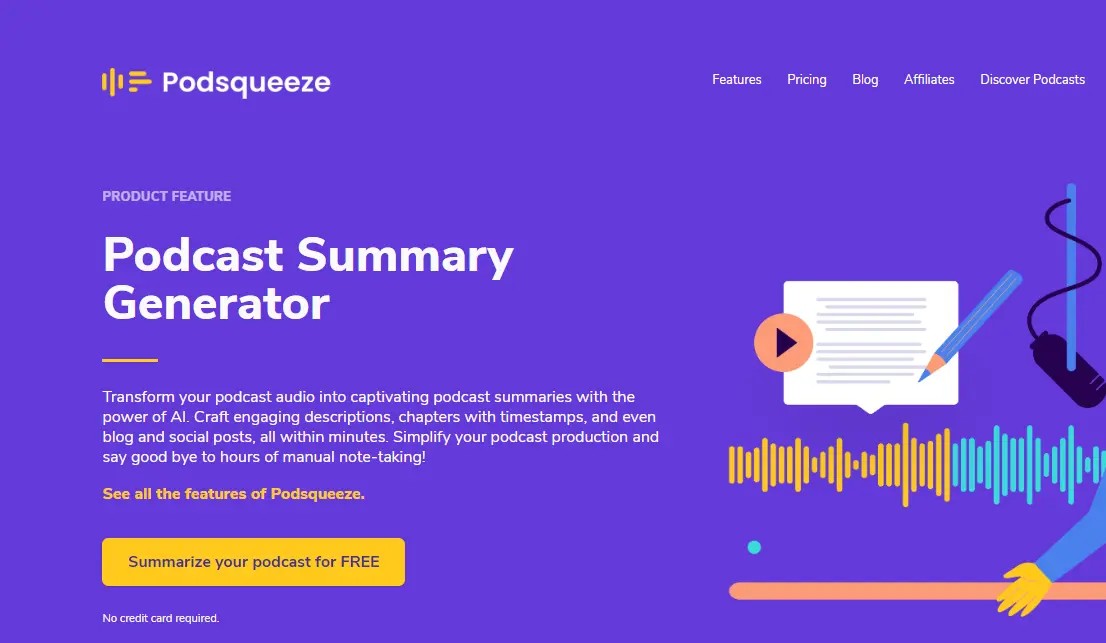
- Sign up here by inputting your details or login with a Google account.
- From there, you'll be directed to your dashboard where you can create any podcast content of your choice. But for this guide, we'll focus only on podcast summaries.
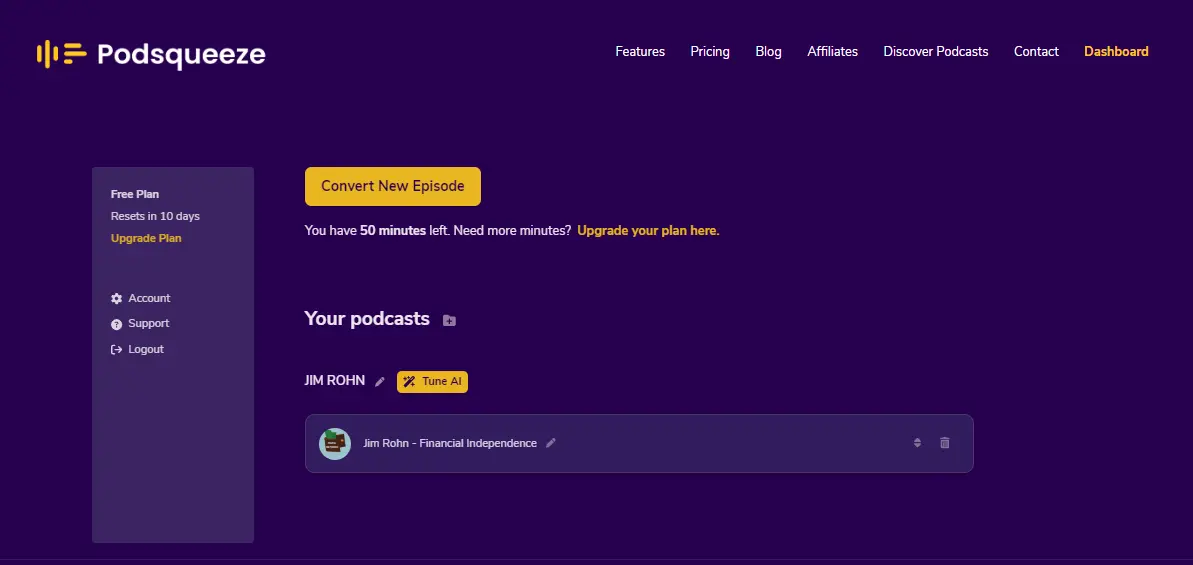
Step 2: Convert your podcast episode
This is where Podsqueeze converts your episode into various podcast content like transcriptions, chapters & timestamps, and of course, your podcast summary.
- Click on the “Convert New Episode” button.
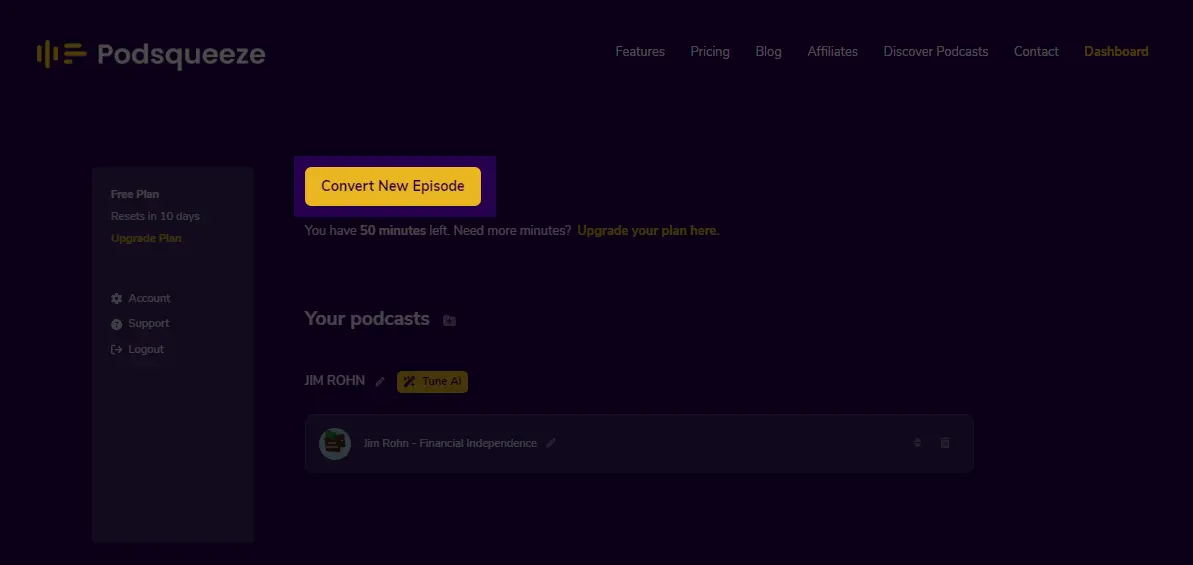
- Upload your audio or video file or search for your podcast on the search bar and select an episode.
- Wait a few minutes and let Podsqueeze do its work.
Step 3: Generate your podcast summary
In this stage, you'll have a complete summary of your episode and other key content for your episode. But here are some key steps to keep in mind.
- Navigate to the “Show notes” section of your episode content and click on “See more and tune”
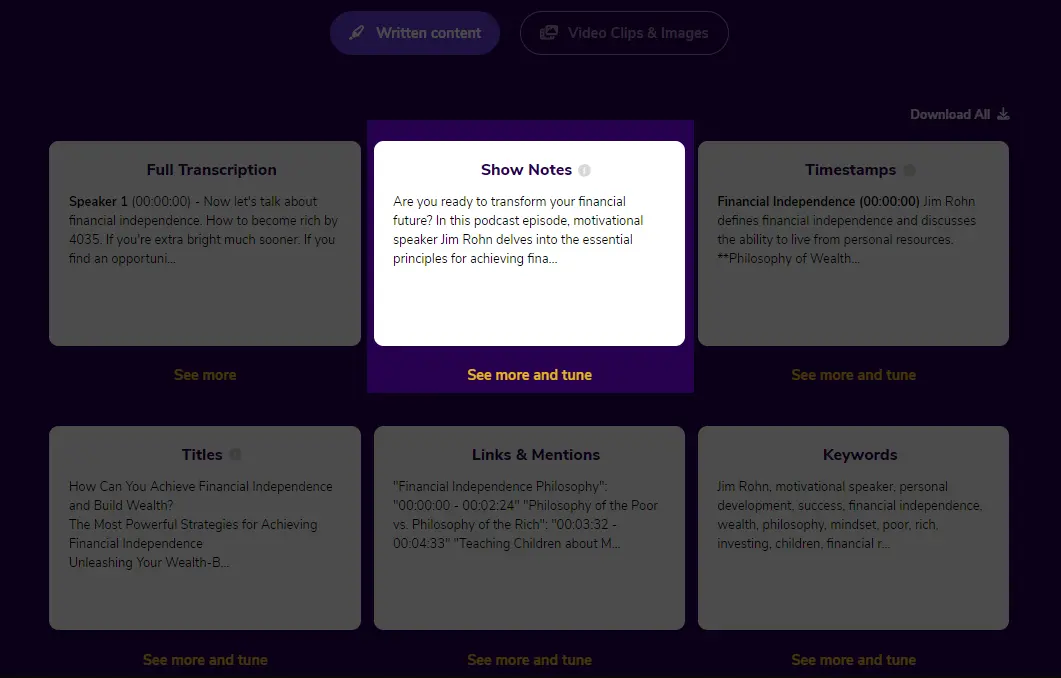
Pro tips: With Podsqueeze, you can tailor the voice of your written content to align with your podcast's style. Just head to your Dashboard, find the "Personalize AI" button next to your podcast's name, and adjust the AI voice settings to suit your preferences.
Step 4: Copy your episode summary
And there you've it, a complete podcast summary tweaked to your liking. You just have to click the copy button and input the summary into your episode.
However, if the thought of using AI to summarize your podcast doesn't appeal to you, and you're not keen on hiring a human copywriter either, we get it. Here's a guide to summarizing your podcast on your own.
How to summarize a podcast yourself
Should you prefer a more personalized touch for your podcast summary, especially if your content covers complex topics that might challenge AI summarization, don't worry. Here are some effective steps to ensure your summaries capture your podcast's essence accurately.
Step 1: Start with a concise intro
A few things are as important in a podcast summary as the intro. It's what brings your summary to life. There are many ways to go about crafting the perfect intro for your podcast summary but here are some examples of what a good summary intro looks like.
- “In this episode” intro: This intro takes potential listeners into what your episode entails from the beginning without wasting time. Here's an example of this type of intro.

-
Question-opening intro: This intro usually starts with a question. However, not just any ordinary question but an intriguing one that will keep potential listeners wanting to know the answers (which can only be found in your episode).
Here's an example of a question-opening intro

-
Friendly intro: This is an intro where you burn the bridge of formality and maintain a conversational tone. It's more like giving an update to friends rather than listeners and often starts with “Hey friends” or any friendly salutation;
-
Hey listeners
-
Hey community
-
Hello dear listeners
-
What's up squad
-
Greetings everyone, etc
Here's an example of a friendly intro.

Step 2: Highlight your episode's core message
This is the point where you give your audiences what they'll get from your episode. It contains some key details and highlights of what you've recorded in your episode. Here are some key points to help streamline how to write this section of your podcast summary.
- Introduce your guest (if any)
- Only give a sneak peek of what the episode is about without spoilers
- Contain all the highlights in one sentence (use commas when necessary)
- Mention about 3 to 5 points you talked about in the episode
With these 5 tips in mind, you're sure to create a captivating highlights section of your podcast summary.
Step 3: CTA
The final touch to your podcast episode summary is the Call to Action (CTA). This crucial section isn't just a conclusion; it's what determines whether listeners will engage further or pass by your content.
Crafting an effective CTA goes beyond simply asking audiences to click on your episode. Here are some strategic ways to encourage listener action without being too direct:
- Close it with a roundup statement: For example, “It was really interesting speaking to (guest name)” or “I loved every moment shared with (guest name), I hope you enjoy!”
- Connect the lesson learned in the episode with your audience: For example, if your guest is an Entrepreneur, instead of a blank “listen to this episode now”, use a compelling CTA like this “his story will guide you through the twists and turns on the road of entrepreneurial success” OR “his story will tell you exactly why you need to start putting yourself on the internet”
That way, you can communicate the lessons and insights of your episode to potential listeners. Think of this section as the summary of your podcast summary.
Step 4: Conclusion
This is a section where you can put whatever you like. It can be the link to the sponsor of your show, resources mentioned during your show, the social media link of the guests, your lead magnet, link to your episode landing page, podcast transcripts, or chapters & timestamps.
Best tips to remember when summarizing your podcast
Here are some advanced tips and best practices to remember and elements to look out for in your podcast summary. It doesn't matter if your summary is done by Podsqueeze AI or manually by you or a copywriter, these tips will come in handy.
-
Stress episode key takeaways when summarizing
Nothing beats your episode key takeaways when writing a podcast summary. These takeaways are the meaty part of your podcast summary and they decide if an audience will listen to your episode or not.
They are the summary of what potential listeners will get when they click on your episode. In this part of your summary, it's important to find a sweet spot because you don't want to overshare everything you talked about in the episode, and at the same time, you don't want to undershare. Here's an example of a podcast episode that accurately implements this;

To find the sweet spot, only share intriguing parts of the episode or share it as a list (with short sentences). That way, potential listeners can skim through what the episode is about without spending too much time.
-
Maintain a conversational tone in your summary
If you are summarizing your podcast with Podsqueeze, you can simply personalize the AI to write your podcast's summary with a conversational tone and even ask it to start with “Hey friend”, “Hello dear listeners” or any friendly greetings the fit your show's voice.
When manually writing your podcast summary, adopting a conversational tone as if you’re speaking to a single listener can make a significant difference. Imagine you’re sharing the episode’s highlights with a friend. This personalized approach not only makes your summary more engaging but also fosters a stronger connection, enticing individual listeners to explore the full episode.
-
Be concise and only summarize
Podcast summaries should provide a brief overview of your episode’s content. Aim for conciseness, using clear language and streamlined sentences. Content writers at Spotify even recommend keeping summaries to three sentences, ensuring they're succinct yet informative.
-
Let your summary fit your episode theme
It won't be a good thing for your podcast if a potential listener finds the vibe in your podcast summary energetic and finds the actual episode dull or vice versa. The energy in your podcast summary should match the energy you portrayed in the full episode.
If your podcast episode is jovial, energetic, and questioning, your summary can start with a question, be energetic, and give off the vibe of the overall theme of the full episode. In short, your podcast summary should set the tone for the full listening experience.
FAQs on how to summarize a podcast
-
Why is summarizing my podcast important?
Podcast summarization is crucial for audience engagement. In today's fast-paced world, potential listeners often decide whether to invest time in a podcast based on a quick overview (skimming) of what your podcast summary entails. With a well-crafted summary, potential listeners can get a snapshot of the episode's value, enticing them to explore further.
Learn more: 17 Inspiring Podcast Show Notes Examples to Elevate Your Show
-
How long should a podcast summary be?
The perfect length for a podcast summary varies, influenced by the content's complexity and what your audience prefers. Generally, strive for a summary that's both brief and detailed, falling between 100-200 words. This range allows you to cover key points without burying the reader in extraneous details that might not encourage them to become a listener.
Learn more: How Long Should a Podcast Description Be? Tips & Examples
-
Is it necessary to include a call-to-action when summarizing my podcast?
Yes, having a call-to-action when summarizing your podcast is essential for guiding listeners on the next steps (to click the play button). There are many uses of your CTA like encouraging potential listeners to listen, to subscribe, share the podcast with friends, or to provide feedback. A well-placed CTA enhances audience interaction and fosters a community around your podcast.
-
How do I maintain a conversational tone when summarizing my podcast?
To sustain a conversational tone, envision yourself explaining the episode to a friend and not a crowd (this is easy to do with our summary generator tool). Use informal language, avoid unnecessary jargon, and include a touch of personality. This approach helps establish a connection with the audience, making the summary more relatable and enjoyable to read.
Repurpose your podcast content with AI